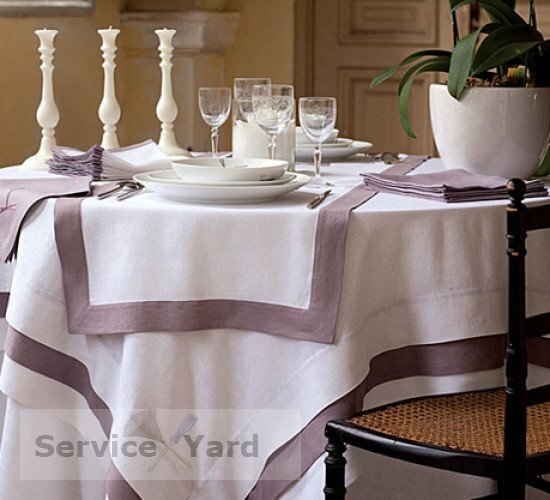
- Recipe # 1.Traditional
- Recipe # 2
- Recipe # 3
- Recipe # 4
- Recipe # 5
- Dry starching process
- How to starch a knitted thing?
- How to Starch Knitted Boots?
The cleverly laid table napkins are that attribute of a cosiness in the house which is transferred through the decades. Especially beautiful look snow-white patterned napkins, crocheted. In this article, we'll show you how to starch napkins so that they give the table a solemn appearance. There are several ways of starching, and each of them has its own little secret.
to the contents ↑Recipe # 1.Traditional
 To quickly and easily cope with the question of how to starch the napkin properly, you will need water, potato or cornstarch. Preparation:
To quickly and easily cope with the question of how to starch the napkin properly, you will need water, potato or cornstarch. Preparation:
- A tablespoon( 15 g) of starch should be diluted in a small amount of cold water until a uniform milk is obtained.
- In a small trickle, pour the resulting solution into boiling water, while stirring gently. Must be a sticky mass.
- If lumps appear, then strain the paste through gauze.
- Cool the solution to a comfortable temperature( to withstand the hand).
- Immerse the napkins in the adhesive for 10-15 minutes.
- Remove the napkins and squeeze out gently. You can not unscrew it.
- Hang the product on the clothesline for drying. Remove the napkins still wet, and then iron it.
Important! Starch is the product immediately before use, since the slightest break on the fabric will ruin its appearance.
Tips:
- If you want to slightly starch the napkin, then use 1 tsp.starch.
- If you want to starch the product "hard", so that it keeps as long as possible the right shape, then use the recipe ratio of 2 tbsp.l.starch per 1 liter of water.
- You can add a little salt( pinch) to the solution so that the starched napkin has a glossy appearance.
- For drying, it is better to spread the napkin on a flat surface( preferably on a towel), straighten all the patterns and give the shape that you want. If you do not do it in time, you will not be able to change the type of accessory later on.
- Use medium iron heating mode to iron the napkin. You need to iron through the cloth with quick movements. Crochet crocheted napkins should be fastened with pins so that during ironing it does not stretch and wrapped.
Recipe No. 2
Another way of how to starch wipes at home is without much effort. To prepare the paste:
- Boil a small amount of water and add a tablespoon of starch. Stir thoroughly and dilute this mixture with cold water.
- Then follow the same as in recipe number 1.
Recipe No.3
To starch a snow-bound crocheted napkin, use milk and rice starch.
You will need:
- 1 liter of skim milk;
- 1 tbsp.l.rice starch.
Method of use:
- Dissolve the starch in a small amount of cold milk.
- Bring the remainder of the milk to a boil.
- Pour into the mixture, stirring thoroughly.
- Cool the paste.
- Dip the napkin for a few minutes in the resulting solution.
- Remove the product and press it gently.
- Place the napkin on a horizontal surface, gently spreading.
- Iron the product from the wrong side after drying.
Important! If you iron the napkin damp, do it from the front side from the center to the edges. If you want to give the napkins a special shape, for example, to fold them correctly, then you need to do this immediately after you have finished starching the napkins so that the thing is slightly damp.
to Contents ↑Recipe No.4
Another interesting variant of how to starch napkins - they can be "candied".For this you will need:
- 3 tbsp.l. Sahara;
- 100 ml of water;
- teaspoon of starch.
Preparation:
- Dissolve in 100 ml of hot water 3 tbsp.l. Sahara.
- Put the solution on a slow fire.
- Dissolve the starch in cold water.
- In boiling water with sugar add the dissolved mixture, thoroughly stirring.
Important! Sugar will make napkins more rigid, but remember that it will attract wasps, flies, ants and other insects. Therefore, it is necessary to use such interior items immediately for the celebration, and after its completion - to wash thoroughly. It is desirable to apply this method when you are wondering how to correctly starch napkins to decorate an apartment, rather than a private house where the risk of attack of insects is much higher.
to the contents ↑Recipe No.5
 To give the interior objects a clear, more rigid form, you can use PVA glue:
To give the interior objects a clear, more rigid form, you can use PVA glue:
- Dilute the glue with water in a 1: 2 ratio.
- Lower the product by 10-15 minutes so that it is completely impregnated with the adhesive.
- Remove and gently press.
Important! This option can be applied in order to cope with the question of how to starch napkins or things of black color. But, to avoid the bleaching of a saturated color, treat the fabric with a very weak solution from the spray gun. If you doubt that you can do it right - buy a special tool for dark things.
to Contents ↑Dry Starch Process
There are times when you do not want to bother with brewing a paste or do not want time. We suggest a dry method:
- Place the product on a blank sheet of paper.
- Lightly moisten it from the spray gun.
- Densely fill with starch, lightly rubbing.
- Cover the product with another sheet of paper and iron with a hot iron.
How to starch a knitted thing?
Linked with their own hands, this thing is a real work of art, so I want the creation to remain in its original form for a long time and the question arises how to starch a knitted thing? To give a volumetric vase, a box, etc., starch is not suitable. It does not give enough rigidity. In addition, after a certain time it turns yellow. Therefore, for products made from white and light yarn, it is better to use sugar, and for threads of a different shade gelatin is suitable. How to apply them correctly - see below.
Method 1
You will need for 1 liter of water 15 tbsp.l. Sahara. Starching a knitted thing using this technology is easy if you act like this:
- Pour the required amount of water into the pan.
- Add sugar and mix thoroughly.
- Bring to a boil, then remove from heat and allow the solution to cool to a temperature that does not burn your hands.
- Lower the knitted object so that the water completely covers it.
- Leave the product for 5-10 minutes under water, then remove and gently wring out.
- Place the item on a flat surface on a prepared dry towel.
Important! Do not forget that starched things do not like water. That is, after washing you will again have to perform the procedure of starching.
Method 2
Use gelatin or PVA glue to give firm knit stiff objects. Gelatin forms a transparent film on the product, while leaving no traces. When processing gelatin, the thing will have a more severe appearance than with starching.
You will need 1 tsp.gelatin and 1 tbsp.water.
Preparation:
- Fill with 1 tsp.gelatin with water.
- Allow it to swell for 1 hour.
- Heat the mixture without boiling.
- Immerse the knitted thing in hot gelatin.
- Remove the product and pull it onto the mold.
Important! Instead of gelatin, you can use PVA glue spreading it in a 1: 1 ratio and simply soak a wet object. After starched knit things with your own hands, dry them on three-dimensional objects of suitable shape: glasses, bowls, dishes. If you use a box of cardboard, then lay it with polyethylene, so that the product does not get stuck when it dries.
to the contents ↑How to starched knitted boots?
To return the original look to knitted boots will help starch or gelatin. Before starching knit boots with your own hands, choose the appropriate proportion of the product to give a more rigid form, given the following recommendations, and read the rules of technology:
- For white and any other light tones, use starch.
- If the boots have a wide bootleg and you want them to "stand", then use 2 tbsp.l.for 1 liter of water.
- If the bootleg is soft and you want to assemble the shoes in the "accordion", then take 1 tbsp.l.for 1 liter of water.
- Use the traditional recipe for making paste.
- To make the boots well soaked hold them in a solution for 7-10 minutes, then pull it out, gently squeeze and dry it in a straightened form.
- Make them form wet.
Important! For dark boots, use gelatin, as indicated in the recipe above. A more expensive way of starching knitted boots is by applying a spray. It can be bought in a shoe store or in the economic department. After processing your boots will have a neat appearance and become as new.
In order to give your fabric accessory an elegant look, use any of the methods and the starch recipe given in this article. We hope that the result will amaze not only you, but all your friends.



